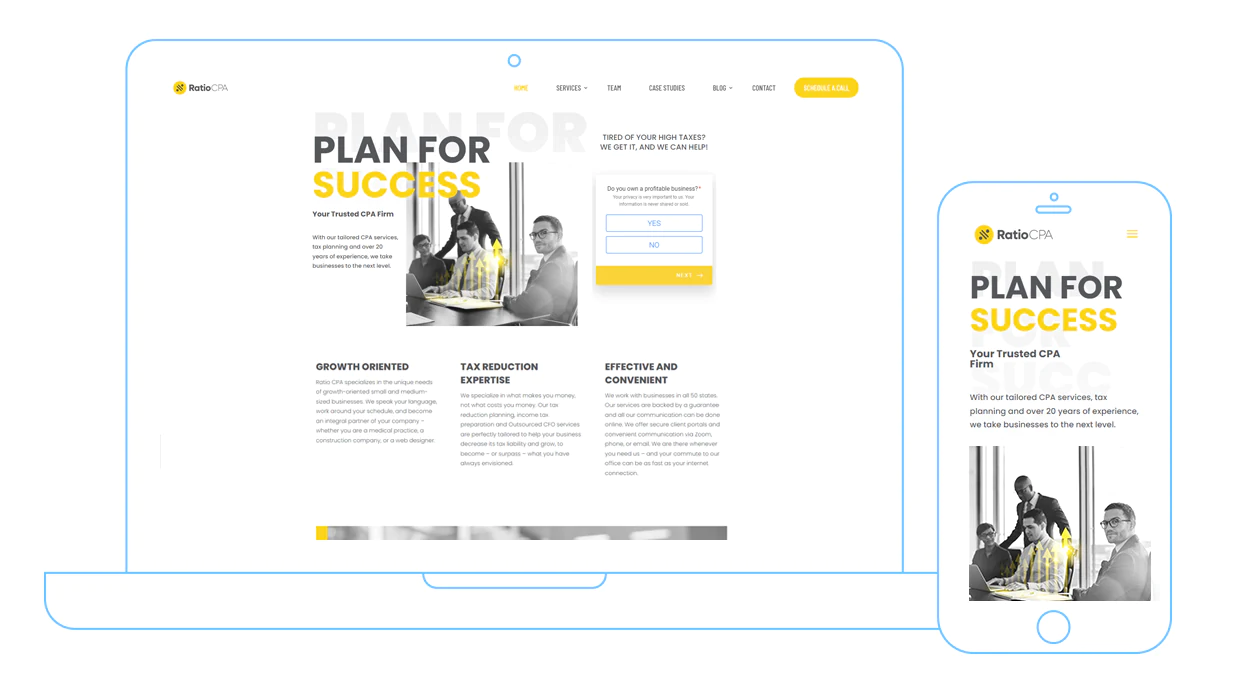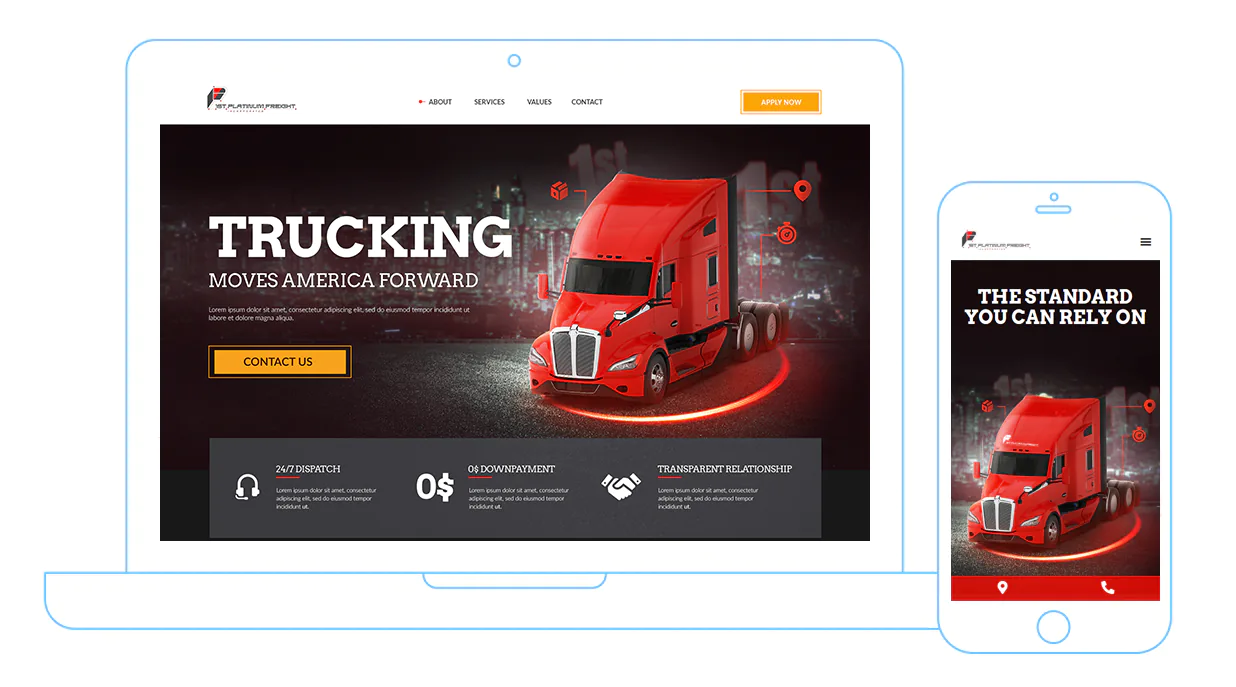
MA Team can help you build the perfect web design for your company’s website. Our web design process has been proven time and again to deliver you a beautifully crafted website that is customized and based on your needs.
Chicago BasedWeb Design Agency
Request a Free Quote
By clicking Send Message, you agree to send your info to MA Team Marketing Agency who agrees to use it according to our Privacy Policy.
This site is protected by reCAPTCHA and the Google Privacy Policy and Terms of Service apply.
Design beyond marketing
Why Web Design Is Important for Your Business?
A good web design can make the difference between your business’s success and failure.
Your website’s design is a crucial part of your online marketing presence. People form positive or negative experiences within seconds of looking at something. It’s a fact. This is why it’s crucial to catch a positive reaction in the first moments a person interacts with your website. Of course, most people would prefer to see something beautifully designed rather than an outdated design.
A well-designed website is not just an opportunity for your business to showcase its unique features, but also the chance to create positive experiences with clients.
With that in mind, it’s important you take into account how your design will leave impressions on viewers and what they may do after viewing. Hiring good a web design and development agency is paramount in forming a solid online presence and achieving your business goals.
…
Websites Attract, This Is Why You Should Aim for Outstanding Web Design:
First impressions are everything.
People will judge your business within seconds, which is why leaving a lasting positive effect on your audience should be your priority. If your website is outdated or unappealing, you can immediately put people off and make them leave your website. Beautiful and eye-catching websites will not only keep customers on your page longer but leave a lasting positive impression as well.
It builds trust with your audience.
People don’t trust poorly designed websites. If they see your poor design or the information looks outdated, they won’t trust your site. They may view your site as unreliable or shady because you don’t have an updated web design. It’s crucial to build trust with your audience so when they visit your site, they remain longer and come bask to visit your website numerous times.
Your competitors are doing the same.
If you need a reason why web design and web development are important, here’s a big one: Your competitors are already incorporating visually attractive designs on their websites. If you have an old, outdated, and low-quality website, your competitors will outrank you. Having an attractive, modern website design will not only help you stay competitive but can also elevate your brand to new heights.
Chicago IL web design agency
We Are a Web Design Company Focused on SEO and Web Development
We are MA Team, a Chicago-based digital marketing agency, specializing in SEO, website design services, and digital strategies.
Through our SEO and website development, we craft websites that are primed for success. Search engine optimization and web development is a complicated but necessary component of your business.
With your business goals, it is impossible to be good at everything, especially something as complicated as web development or search engine optimization. Nonetheless, it is crucial to have a website design that illustrates and portrays your business in a way you want people to perceive you.
One of our key areas of expertise is creating marketing solutions and web development for businesses.
With our team of designers and marketing experts, our design agency can cover all your needs by creating an outstanding website and steadfast digital strategy.
But here’s the deal, what works for one company may not work for another. This is why it is important to find the right design and web development company that can incorporate both your company’s needs and your clients.
This is where we come in. Let us focus on making your web design look amazing and bring clients running to you. Our web design company can meet all your needs and help with the development of your virtual presence.
At our Chicago web design agency, we will give you the perfect website design that will make your business shine.
We speak to the needs of your customers, creating unique and engaging experiences on every page!
We are not only graphic magicians. We are web designers!
Dive a Bit Deeper Into Our Chicago Il Based Web Design Agency

At our design and development company, we are well equipped. With our team of highly skilled web designers and marketing experts, we build your design and digital strategy from scratch.
Services that our web design company can provide you with include: the full design flow from building your website, developing marketing solutions aligned with your business goals, creating marketing strategies, and executing the final digital strategy.
Our web design process is meant to build your website so it can represent your brand while also speaking to the needs of your customers, creating an inviting experience for them on every page.
Services
Our Chicago Web Design Services
Web design services are a great way to get your business or organization up and running. Web development is the process of designing, building, integrating, scaling, and maintaining.
Our web agency will work with you on the look and feel of the website, making sure it matches your brand style and opts for gaining positive feedback from your audience.
We will supply you with the tools to manage and maintain your website for years to come. Our web development team will make sure that all of your content is updated, well-structured, easy to read/find, search engine friendly, cross-device compatible, and user friendly.
It’s the ideal way to take your brand from a traditional brick & mortar store to an innovative and attractive one.
With our e-commerce services, we will make sure that all of our efforts are focused on making your website as successful as possible.
Inventive design can be a make-it or break-it factor in your website’s appeal. Choosing the right website design will give you a competitive edge over other companies.
A website redesign should be done every 3-5 years if you want to stay ahead of your competition. Consider redesign as a refreshment and tactic to make your website stand out from your competitors.
Our creative team will carefully craft content specifically designed for your image and brand. We know how to write engaging content that will grab your readers’ attention and potentially convert them into customers.
Websites need to be well-maintained in order to attract and retain customers, maintain search engine rankings, and present new information, products, and services to the public.
Depending on the quality of your SEO, your website could be ranked #1 on search engines such as Google, Yahoo, and Bing.
Visibility is very important, and it is important to make sure that your website has the best performance and security at any given time. For this reason, we provide web hosting services that will allow you to access your website with ease, without any downtime for maintenance.
Ready to Grow Your Business With Chicago Web Design Services? Let’s talk!
So, Why Should You Choose Us as Your Web Development Company?
To put it frankly- your website design is the deciding factor between your business’ success and failure. It influences how your audience and customers judge your business and brand.
By having a website design that is aesthetically appealing, UX friendly, and easy to navigate, you can go a long way in improving your brand and user experience.
Our web designers are skilled in SEO and conversion optimization, allowing your website and brand to be at the top of all search results.
…
We Are an SEO-focused Web Agency
Let’s talk a little about SEO.
Simply put: Search engine optimization is the process of improving your website development to increase visibility when people search for products or services related to your business in Google, Bing, and other search engines.
Aside from how content is created in your website design, certain design elements can directly affect SEO and where websites appear on landing pages.
You want to ensure your website is not buried at the bottom of search engine pages, but instead, shooting up at the top so customers can find you quicker and easier.
When you partner up with our web marketing agency, you can rest assured that our team and experience can bring your website to the top!
Testimonials
Testimonials
It's all about you. Meet some of our happy clients.





FAQ
FAQ
Why is web design important?
Your website’s design can be your business’s best marketing tool. Many businesses invest a lot of money just to have an attractive-looking website. Besides looking professional, a good web design builds up trust in customers and helps bring more leads to your website.
What is the most important step in creating a good website design?
The most important part of any website is content. Without content, your website is nothing more than an advertisement, which is not an effective online marketing strategy. The goal of any marketing agency that designs websites should always be to create an online resource for people.
What do we get from a good web design?
It creates consistency. Other businesses and customers will recognize your brand by just looking at things such as colors, logos, or user experience. It is important to include things in your design that will help your customers identify and distinguish your business.
PPC ads are a great investment because they are fast and flexible, meaning it is easy to do a quick experiment. If you find out that an ad isn’t working for your business then changing or stopping it will be simple. This results in high-quality traffic at a low cost which makes them perfect if you’re aiming for conversions on our website.










